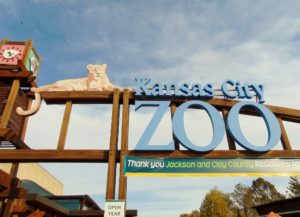
Overall Rating![]()
The Kansas City Zoo was founded in 1909 and is located in Swope Park in Kansas City, MO. The zoo is 202 acres and is home to approx. 1,300 animals. The Zoo is an accredited member of the Association of Zoos and Aquariums and participates in the AZA program called the Species Survival Plan.
Kansas City Zoo Website: www.kansascityzoo.org
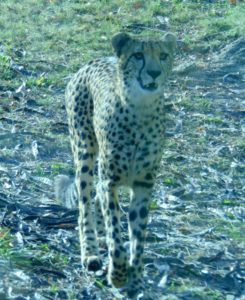
Hours:
Open year-round
Weekdays 9:00am-4:00pm
Weekends 9:00am-5:00pm
Seasonal Hours:
November-February
9:30am-4:00pm
Memorial Day-Labor Day
Monday-Friday 8:00am-4:00pm
Saturday & Sunday 8:00am-5:00pm
March-May, September, October
Monday-Friday 9:30am-4:00pm
Saturday & Sunday 9:30am-5:00pm
Closed:
New Year’s Day
Thanksgiving Day

Christmas Day
Tickets:
Daily Admission
Adults (12-54)-$16.00
Seniors (55+)-$15.00
Kids (3-11)-$13.00
Kids 2 & under-Free
Residents of Jackson & Clay Counties:
Adults (12-54)-$8.00
Seniors (55+)-$7.50
Kids (3-11)-$6.50
Parking: Free
Pet Daycare:
Not available. Service dogs are welcome.
With any extra service provided I would always call ahead for any information.
Restaurants:
The zoo offers several restaurants/concessions.
Tuxedo Grill, Bluey’s Kansas City BBQ, Rafiki’s Restaurant, and the Boathouse Bar.
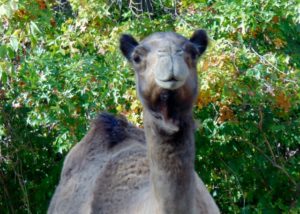
Animal Habitats![]()
Education![]()
Cultural Immersion![]()
Navigation![]()
Food Variety![]()
Click here to find more information on the category ratings.
Our Zoo Experience
Wow! Kansas City Zoo is AWESOME! Steve and I visited the Kansas City Zoo October 19-21 of 2017. It took us one full day at the zoo, but we should have split it into two days.
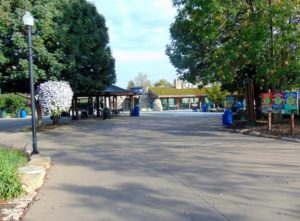
We got to the zoo before the zoo opened. It opens at 9:30 am and closes at 4 pm. When I say it was a full day I mean we had to hustle a bit at the end of the day to finish seeing everything.
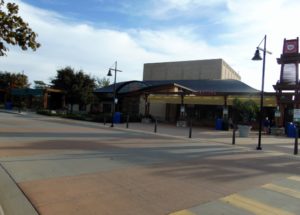
The zoo is divided into two main sections. The front section is made up of the Kidzone, Tiger Trail (Asia), and Australia.
There are also a couple of exhibits at the entrance of the zoo. These include the Polar Bears, the Penguin Building, and the River Otters.
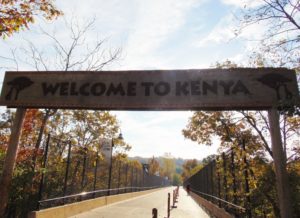
The second section of the zoo is made up of West Africa and East Africa. This also includes an African Elephant area along with a Tropics building located between the two main sections of the zoo.
The zoo sits on 202 acres. Now not all of that is open to the public, however, if you visit I suggest you wear good walking shoes. As I said above we should have made the visit to the zoo over two days.
Let me share with you how we trekked through the zoo. The first thing we did when we got into the zoo was headed straight back to Africa.
There is this giant bridge you have to cross to get to Africa.

They have built Africa where you pretty much have to be at the end of the bridge in Africa before you even see anything. In Africa, you can go left or right to start your trek around a huge loop.
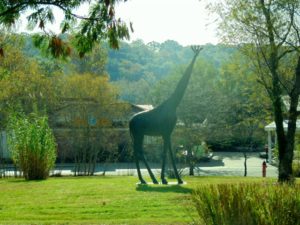
We chose to go right, and I’m glad we did. The first species habitat we came to was the Cheetah habitat.
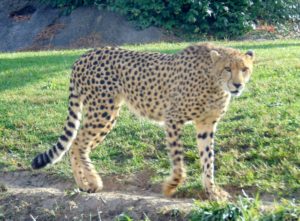
The zoo has three Cheetah brothers. Did you know a group of Cheetah is called a Coalition?
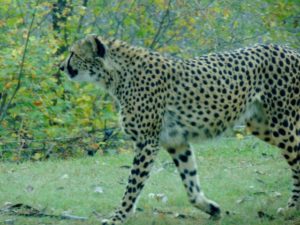
Female Cheetah are normally solitary while related males will stay together. The three boys were up and moving around.
They were amazing to watch. The zoo has set up a boardwalk which runs alongside the habitats. There are also covered viewing windows for visitors to get an up close encounter with the animals at most of the habitats.
We stayed a good 8-10 minutes with the Cheetah. One Cheetah was walking alongside the glass, so we were able to see every amazing feature of the Cheetah.

Another of the brothers was walking the perimeter of their habitat to make sure there were no intruders and everything was safe.
The next encounter you will come to is Warthogs. They were not as active, they were curled up together taking their mid-morning nap. They did have a very nice habitat with a small creek to wallow in on hot days.
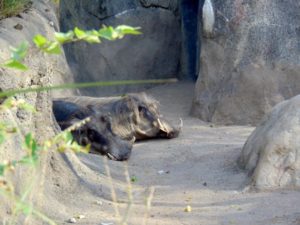
After the Warthogs we came upon the African Savanna exhibit. Here you can walk out on an observation deck overlooking the African Savanna and the animals that call the Savanna home.
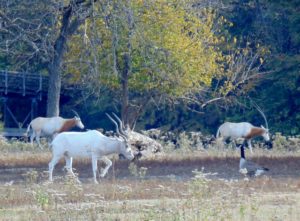
The observation deck is seated out over a watering hole. The zoo has rocking chairs and a covered deck for visitors to relax while watching the animals on the African Savanna.
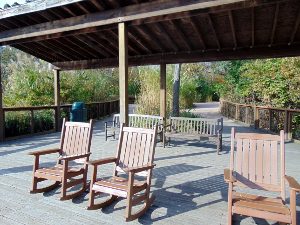
The animals on the Savanna this day were Addax, Springbok, Scimitar-horned Oryx, Eland, Greater Kudu, Ostrich, Giraffe, and Zebra. It was very nice to take a moment and enjoy the view.
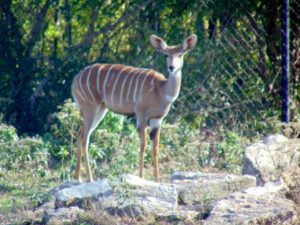
Before we went any further into East Africa we decided to go ahead and visit West Africa.
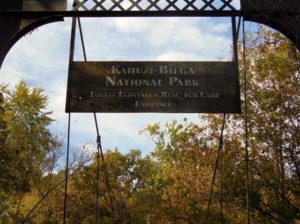
After the African Savanna viewing, instead of continuing left, follow the path straight. You will cross a bridge, it is a really cool swinging rope bridge.
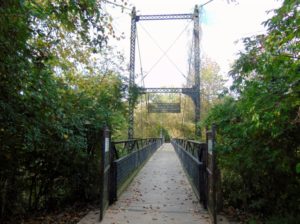
Once inside West Africa we went right at the fork. The first species you will encounter are Black Mangabey (type of monkey).
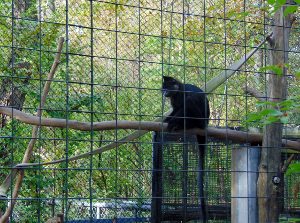
Next is the gorgeous African Leopard. Pound for pound, leopards have one of the most powerful bites of all the big cats. The habitat for the African Leopard was really neat and something I have never seen before.
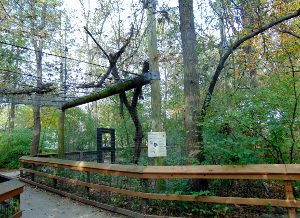
There is a path you follow, on either side of the path is the Leopards enclosure. The Leopard can move from one side of the enclosure to the other by traveling above you.
As you make your way past the African Leopard habitat you will encounter more species that call West Africa home. These species include Bongo, Duiker (small deer), Red River Hogs, and Lowland Gorillas.
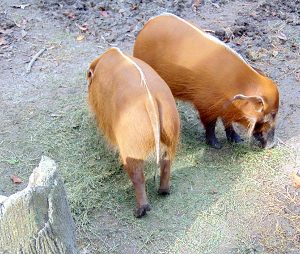
To see a Bongo up close was really neat. Bongo are found in the dense jungles of Africa, they are very shy and rarely seen. The only time we have seen them at other zoos, is from afar.
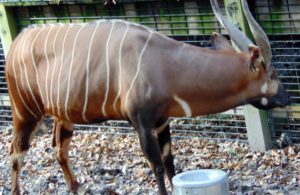
In the Gorilla habitat, there was a huge Silverback Gorilla sitting on a big rock as we walked up. He was cool, after we showed him respect, he didn’t mind that we were there and laid down.
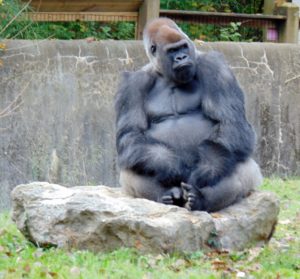
Here are some tips on how to show respect to Gorillas:
- Never look directly at them, stand slightly sideways with your chin lowered. This is especially true if you are an adult male.
- Never show your teeth in a smile. This is a threat towards them.
- Talk softly. Their hearing is as good as or better than ours. So screaming and pounding on the glass isn’t nice.
Ok, we left West Africa, traveled back across the swinging bridge, and turned right to get back on the trail to East Africa.
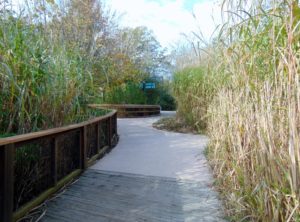
The next species you will encounter are the Ravens and Vultures. Then you will come upon a few species of Tortoise.
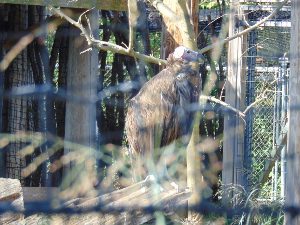
The next species down the trail is Steve’s favorite (after Meerkats, of course), Kirk’s Dik-Dik. I know how it sounds and I know what you’re thinking. Stop it.
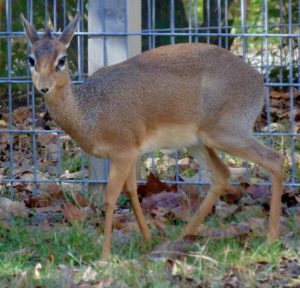
Anyway, Kirk’s Dik-Dik are one of several small deer species. They are incredibly cute. When frightened, they make a whistling sound through their nose that sounds like “zik-zik” or “dik-dik”, from which its common name was derived.
Inside the African Aviary, are of course Birds of Africa, but there is also the most laid back, sunbathing Red Ruffed Lemur. Lemurs are endemic to Madagascar, an island off the east coast of Africa.
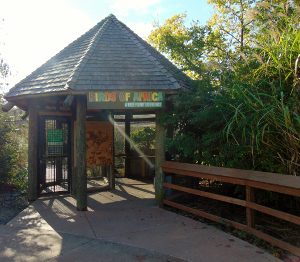
This little guy was kicked back lounging on a log as if it were a lounge chair and soaking up the rays. Ridiculously cute as can be.
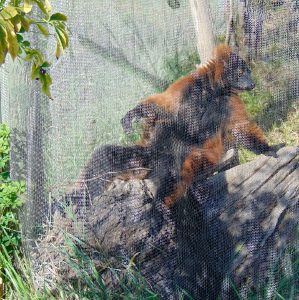
After moving on down the trail, we entered a Kopje. Kopje is a term given to a large group of rocks predators and prey use to survey their surroundings.
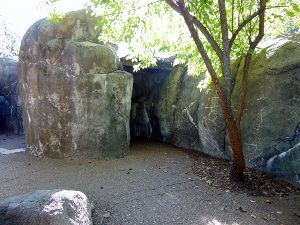
Animals such as Rock Hyrax, Lions, and Caracal use Kopje to scan their territory.
The first species you encounter is the Caracal. The Caracal is a small species of cat, but don’t let their size fool you. They are extremely successful hunters. They have the ability to leap very high and catch birds out of the air.
Right of Caracal were Fennec Fox and Bat-eared Fox.
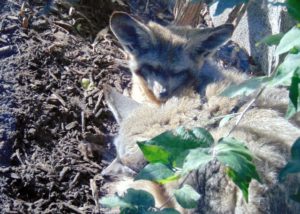
Left and across from the fox habitats are the African Lions. The zoo has three beautiful female African Lions. The three lionesses were laying in the sun and relaxing without a care in the world.
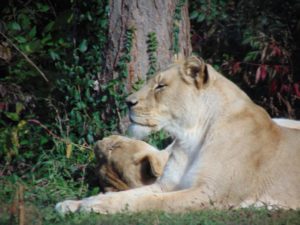
Their habitat is very well suited for them. The way the habitat is built for them is; if they wanted to be seen by visitors they could lay out in the open, but if they are feeling a little shy on a particular day, they could hide behind a hill at the peak of the habitat.
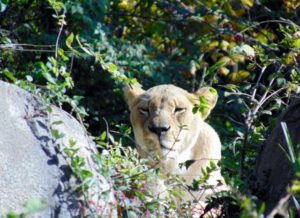
The day we were visiting they had chosen to do half and half. I still got some great pictures.
Down and across from the Lions, is species of cat called the Black-footed Cat (they are highly endangered).
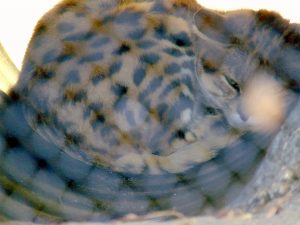
Next to the Black-footed Cat is the most adorable of the small cats, the Sand Cat. This cutie pie had only think on her mind and that was nap!

The last habitat in the Kopje is the Rock Hyrax. The Rock Hyrax shares their habitat with not only African Birds but also with a lizard.
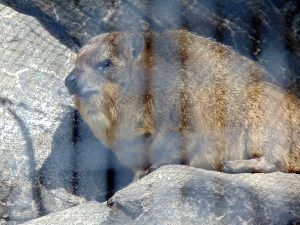
Co-habitation is when zoos will have more than one type of species in the same habitat.
We exited the Kopje and continued on down the trail to the Black Rhino. The Rhino was not impressed with the day and was napping in the sun.
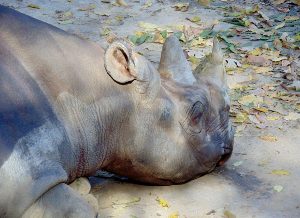
Do you know one difference between a Black and White Rhino? The White Rhino is called the White Rhino because of his wide upper lip. When the English misunderstood the German word for “wide” as “white” the name stuck.
To tell the Black Rhino apart from the White Rhino, look at their upper lip too. They have a more pronounced point to their upper lip.
At the Rhino habitat we took a right and the trail lead us to the Chimpanzees. We went inside the Chimp building but did not see any of the Chimps through the viewing windows.
We stayed in the building for a bit reading and looking at all the education provided about the Chimpanzee there at the zoo. Once we finished we exited the building and headed back out on the trail.
The trail followed along the Chimp habitat for a bit, then Steve noticed a Chimpanzee coming out of the trees and brush. Then another, then another, and so on.
Turns out the entire troop, several times during the day, will walk their territory to make sure no intruders have breached the perimeter. We happened to catch them as they were coming back from a scout.
We left the Chimpanzees and walked down the trail where we came to the Crocodile Research Station on the Nairobi Wildlife Reserve. Inside is a Slender-snouted Crocodile in his pond.
There is a mural on the wall inside the building showing the difference in size of a few different species of Crocodilian. It is amazing to compare your size to some of the largest Crocodilian in the world. You suddenly feel very small.
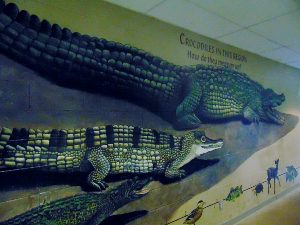
We moved on and encountered one of Africa’s deadliest species, the River Hippopotamus. More people are attacked and killed by Hippos every year than any other species in Africa.
Hippos are notoriously territorial. This Hippo was in her pool playing with one of her pool toys. She was pushing it around under water and biting it.
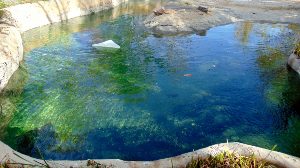
After you leave the Hippo habitat you will trek a good distance around a rather large pond before entering the Ruwenzori Island Reserve in Uganda.
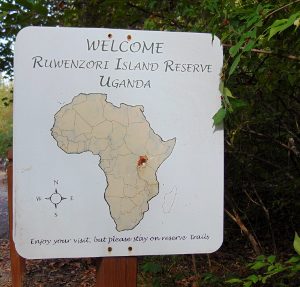
Here you will encounter a pack of African Painted Dogs and a troop of Baboons.
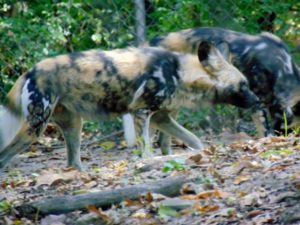
The trails in this part of the zoo are very peaceful and beautiful.
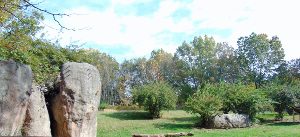
Once we hiked back across the river we sat and had lunch at Rafiki’s Restaurant.
Steve had a Hamburger and French Fries (of course), and I had African inspired Chicken Kabobs. We also learned a bit of Swahili.
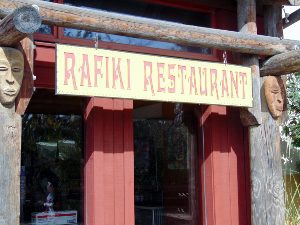
There is a sign on a pillar under a picnic seating area outside the restaurant. On the sign are different phrases in Swahili. Jambo (hello) and Habari (how are you?) are a couple of the phrases we learned.

I don’t really know how Steve did it, but after lunch, he got me to ride the Skyfari with him. If you don’t know what this is, just think ski lift without the snow.
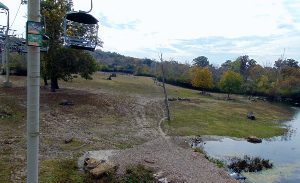
This Skyfari goes from Rafiki’s Restaurant over the African Savanna to the other end near the Chimpanzees.
I’m scared of heights, I know I’m a pansy, I did enjoy the Skyfari a little bit. I also got some great photos. I really enjoyed being on the ground a little more though.
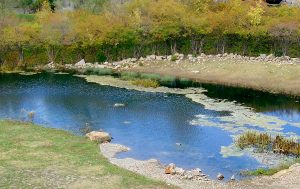
You can make a one way trip or a round trip on the Skyfari. Once we returned to Rafiki’s Restaurant we hopped on the Tram and took it back across the big bridge to the front of the zoo.
The Tram will take you around a bit of the Elephant habitat, however, for a really good view I would recommend walking back to it.
The Tram runs all day between the entrance of the zoo and Africa. It will also take you to Asia and Australia in case it is too far for you to walk. The number of trams running depends on how busy the zoo is that day.
We decided to get off at the Sea Lions. This allowed us to walk back over to the African Elephants. We walked over to the Elephant watering hole and saw the beautiful African Elephants.
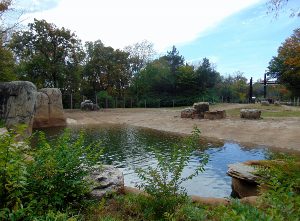
There are bathrooms located in this area of the zoo. The thing I really liked was they built the bathrooms to resemble African village huts with thatched roofs and mud walls.
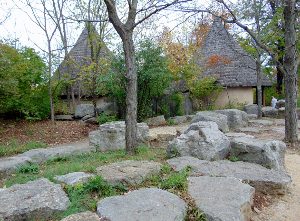
There were also huge rocks placed around the watering hole in a bleacher like way for visitors to sit and listen to Keeper Talks. You can also sit and relax there while watching the Elephants.
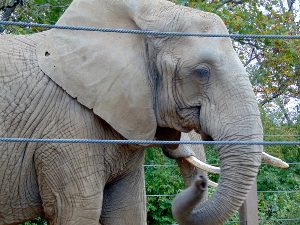
After visiting with the Elephants for a bit we walked back toward the entrance but turned left on Beaks and Feet Street. Here along the path/road the zoo has a few different species.
Here you can encounter species such as Bobcat, Tamarins, Iguana, and an Eagle Owl.
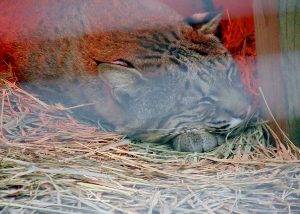
Next you can walk up the trail back toward the Tropics Building.
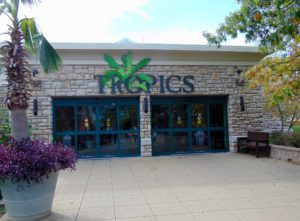
Inside the Tropics building you will encounter River Otters, Tamarins, Gibbons, Prehensile-tail Porcupine, and a few other African and South American species.
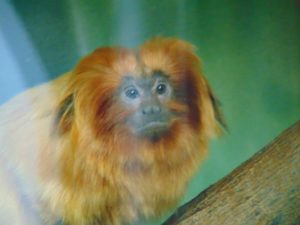
Something I thought was super cool, there is a table which has a bunch of Petroglyphs carved into a stone slab. You can place a brown paper towel on top of the glyphs, use a pencil to rub over the paper towel and glyphs making a rub of the glyph.
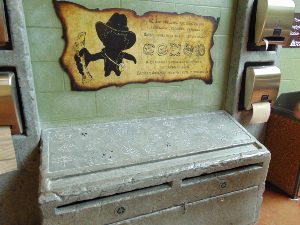
Leaving the Tropics building we decided it was Penguin time. The Helzberg Penguin Plaza is equipped to handle, what Steve and I call, Hot Penguins (any species of Penguin not found in Antarctica) and Cold Penguins (only five specie live in Antarctica).
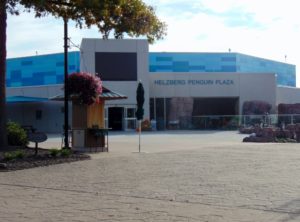
The African Black-footed Penguins are able to go in or outside, dependent upon the temperature outside. African Black-footed Penguins are found in South Africa.
The King, Gentoo, and Southern Rockhopper Penguins are in a temperature controlled room with their own snow machine and a cold, deep pool they can swim in.
There was a King Penguin laying directly under the snow machine. The snow was falling on top of him to the point where it was starting to bury him. It was super cute.
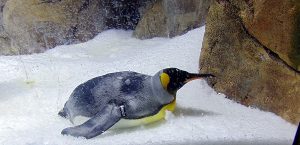
There are three levels to the Arctic Penguin habitat. The farther you walk around and down the walkway, the more you go under the surface of the water. You can see under the water of their pool through big viewing windows.
On our way to the Tiger Trail and Australia we stopped by the Discovery Barn to see Steve’s all-time favorite species, Meerkats!
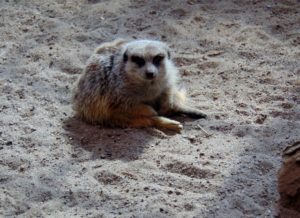
In the Discovery Barn is where the Meerkat and Ringtail Lemur habitats are. The Meerkats were soaking up as much sun coming through the windows as they could.
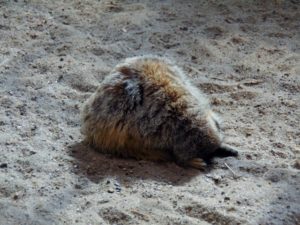
On to the Tiger Trails! You will trek a pretty good distance. Once down the hill, winding through the paths, and past the happy Buddha, the first Asian species you will encounter is the Orangutan.

This habitat is super neat with two stories of viewing. This is really cool because if the Orangutan is up on top of her jungle gym, you can still be mostly eye level with her from the upper viewing area.
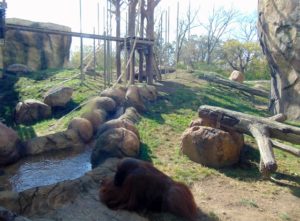
Next we made a bee line for the Red Panda habitat. No matter the day I’ve had, you show me a Red Panda and I’m going to smile. Did you know Red Pandas aren’t pandas at all? They are actually related to the Raccoon.
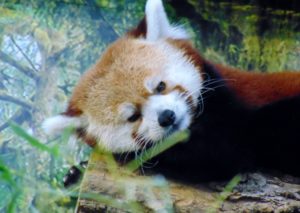
After the Red Panda we round the corner and I am stopped in my tracks. Straight in front of me are two of the most beautiful Sumatran Tigers I’ve ever seen. For a few moments me and one of the tigers lock eyes. I am speechless.
They were both laying facing the visitors viewing area. Laying completely still with the most intense stare. Then one of the males got up and decided to show off his stripes.
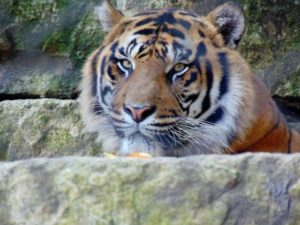
Watch out, sometimes tigers like to spray toward people. It is their way of saying this is my area, stay out! If you ever see a tiger turn its butt toward you and lift their tail, my advice, back away quickly.
Australia has some of the most unique animals in the world. Did you know, all but one species of Marsupial live in Australia?
We started our walkabout off right, we went through an Australian Aviary. In the aviary you will encounter Australia’s largest bird, the Emu. Did you know Emu eggs are a dark green color?
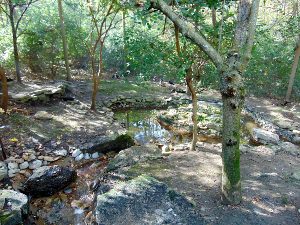
One animal we had not seen before in other zoo trips, is the Dingo. I saw my first Dingo at the Kansas City Zoo!
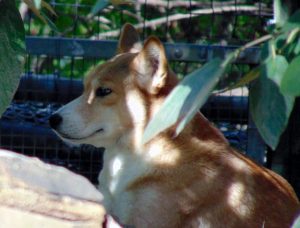
I snapped a few photos of the adorable tiny Wallaby and rounded out that section of the Australia exhibit with a visit to a Matschie’s Tree Kangaroo. The Matschie’s Tree Kangaroo is totally arboreal.
As you round the last corner before you exit the Australian exhibit, you will encounter a sassy Camel.
So, we were walking along and came up to the Camel habitat, and of course Steve says “Hey, I wonder how many times a day he hears, “Hump Day”, probably a lot, huh?”

Anyway, this Camel mean mugs us all the way out of Australia.
One thing I would like to mention, the Red Kangaroos in the zoos Australia exhibit are completely free roaming.
There are about three mobs of Red Kangaroos. The Kangaroos hop around where ever they want. It is very unlikely, however, that they would intentionally hurt anyone unless provoked by some idiot.
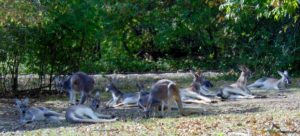
Once we walked through the Australian Herpetarium and finished our walkabout we headed for the Polar Bears and River Otters at the entrance of the zoo.
Unfortunately, we did not get to see the Polar Bear, however, his habitat is super awesome and very enriching. The Polar Bear has a huge pool, a waterfall, and lots of big rocks to play on and hide behind.
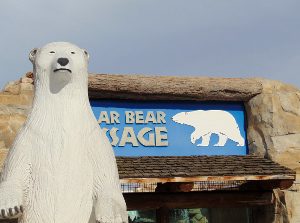
There is a viewing area inside the building where you can sit on bleachers and listen to Keeper Talks. There is also about 180 degrees of viewing area outside.
The North American River Otters also have a super cool habitat. They were very active too. We were standing on the dry (or land) side, one of the Otters was on the dry side. The other Otter kept getting in and out of their pond. He was also yelling at the Otter on the dry side. I think he was yelling for him to come and play.
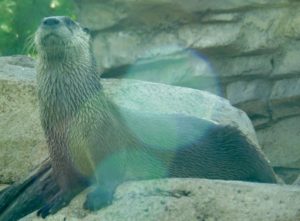
We watched them for a couple more minutes, then went to the gift shop. In the same building and connected to the gift shop are some concessions and a restaurant. We purchased our magnet and decided to call it a day.
Like I stated in the beginning of this story, we should have visited the zoo in a two day period.
Kansas City Zoo is super awesome, I hope we can visit again someday soon.